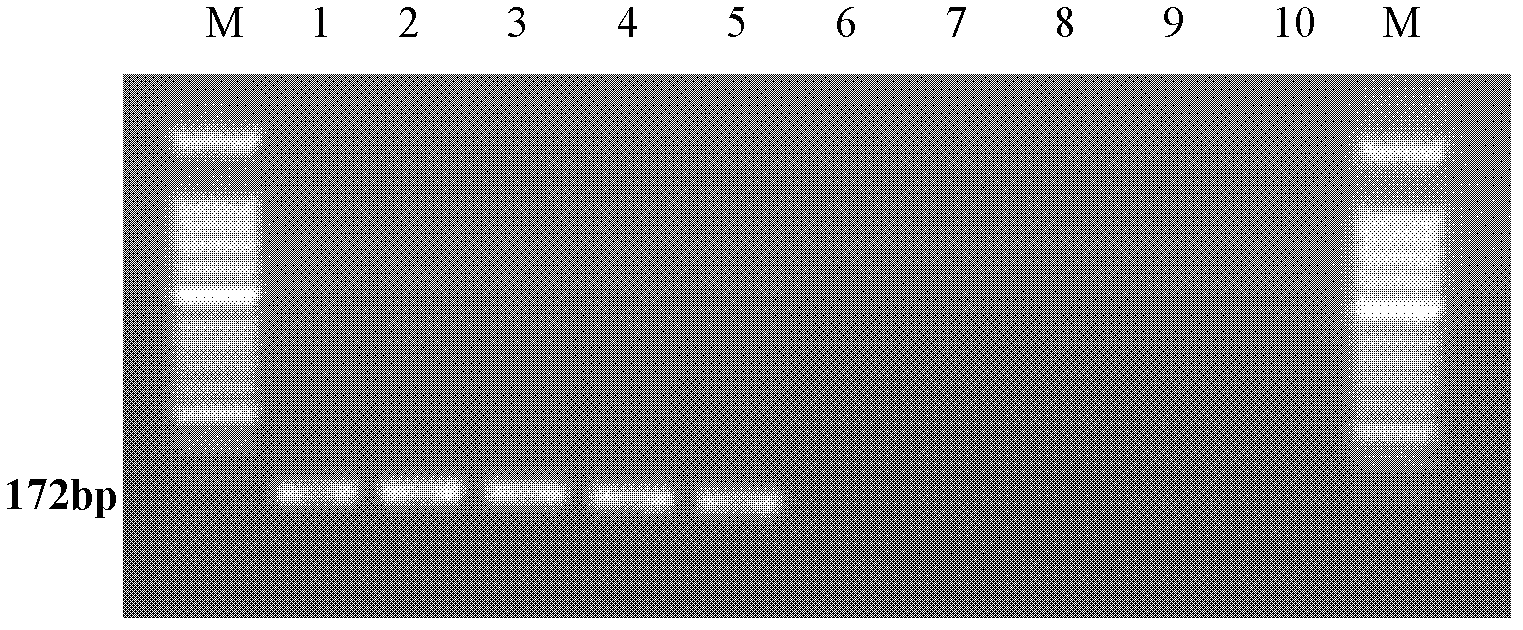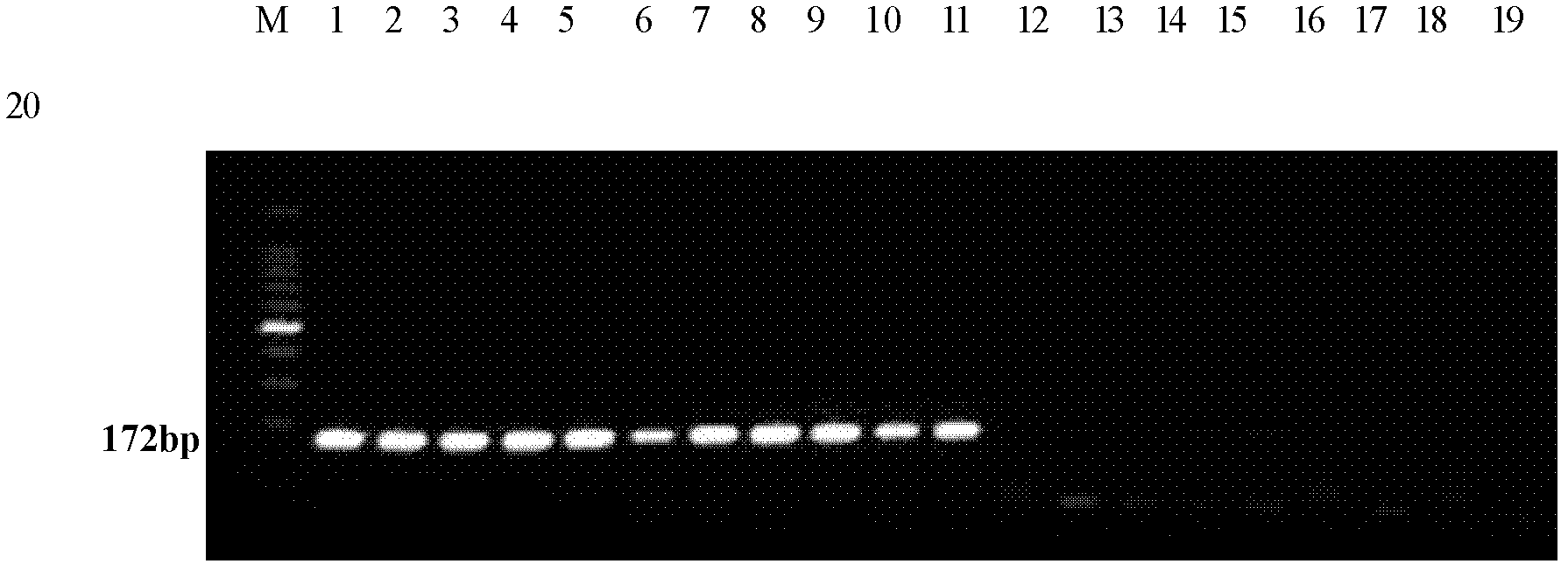Molecular detection method aiming at Asia fusarium and application thereof
A technology of molecular detection and detection method, which is applied in the field of crop disease diagnosis and identification of pathogenic bacteria, can solve problems such as pollution and complex identification methods, and achieve the effect of simple operation method, simple and clear measurement results, and few operation steps
- Summary
- Abstract
- Description
- Claims
- Application Information
AI Technical Summary
Problems solved by technology
Method used
Image
Examples
Embodiment 1
[0026] According to the identified 42 Fusarium sub-Asian and 30 Fusarium non-Asian species, the amplification and comparison of Fusarium sub-Asian and non-Asian Fusarium were carried out by using sequence-related amplified polymorphism (SRAP) markers. pair analysis. The amplified SRAP markers are based on SRAP polymorphism markers of introns and exons in the gene sequence, and such polymorphism markers often represent polymorphisms (that is, differences) between genes. From nearly 400 markers, we found SRAP markers that can only be amplified in Fusarium subascensus but not in non-Asian Fusarium species. The sequence of the SRAP marker is SEQ ID NO.3, and its size is 172bp. By sequencing this marker and comparing it in NCBI's GeneBank, it was found that this is a new gene that only exists in Fusarium sub-Asia, and no homologous sequence has been found in the sequences of other Fusarium. We redesigned the primers for this marker.
[0027] Design a primer pair specific to the m...
Embodiment 2
[0053] The collected Fusarium strains were typed using specific primers.
[0054] Fusarium strains were collected from 7 provinces and autonomous regions in China, and the inventor defined them as: 0901, 0914, 0919, 0920, 0922, 0923, 0924, 0925, 0950, 0968, 0978, 0938, 0943, 0956 , 0966, 0822, K11, 2E22, 2041, 0825, and the collection places corresponding to each strain are recorded in Table 2.
[0055] The strain DNA sample was extracted using the improved SDS method, adding 200 μL of extraction buffer (4% SDS, 100 mM Tris-HCl, 10 mM EDTA) to an appropriate amount of mycelia, warming at 65 ° C for 30 min, and then quickly moving it into an ice bath for 30 min, adding 200 μ L of chloroform-iso Pentanol (24:1) extract was shaken and mixed, centrifuged at 12,000 rpm for 5 min, and 120 μL of isopropanol was added to the supernatant to precipitate DNA, ddH 2 O dissolves DNA. Take 10-20ng DNA into the PCR reaction system.
[0056] The PCR amplification reaction, amplification pr...
Embodiment 3
[0063] Surveillance of wheat contamination by Fusarium asiaticus.
[0064] Wheat kernels were collected from diseased wheat kernels and healthy wheat kernels from Taizhou and Wujin wheat districts in Jiangsu Province, Lu'an wheat districts in Anhui Province, Shangcheng and Huangchuan wheat districts in Henan Province, and Xiangfan wheat districts in Hubei Province.
[0065] DNA Extraction from Wheat Kernels
[0066] Wheat grains were collected from Taizhou and Wujin Mai Districts in Jiangsu Province, Lu'an Mai District in Anhui Province, Shangcheng and Huangchuan Mai Districts in Henan Province, and Xiangfan Mai District in Hubei Province. Healthy wheat grains or diseased wheat grains were taken, freeze-dried with liquid nitrogen, ground and pulverized, and DNA was extracted by the modified CTAB method (Zhang, 2004) (same as Example 1). Take 40-50ng DNA into the PCR reaction system.
[0067] The DNA of the wheat sample was subjected to the PCR amplification reaction, the amp...
PUM
 Login to View More
Login to View More Abstract
Description
Claims
Application Information
 Login to View More
Login to View More - R&D
- Intellectual Property
- Life Sciences
- Materials
- Tech Scout
- Unparalleled Data Quality
- Higher Quality Content
- 60% Fewer Hallucinations
Browse by: Latest US Patents, China's latest patents, Technical Efficacy Thesaurus, Application Domain, Technology Topic, Popular Technical Reports.
© 2025 PatSnap. All rights reserved.Legal|Privacy policy|Modern Slavery Act Transparency Statement|Sitemap|About US| Contact US: help@patsnap.com



